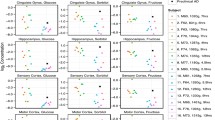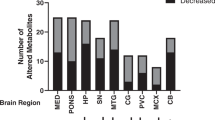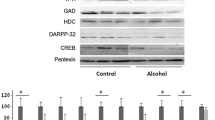Summary
Quinolinic acid (QA) content was measured in postmortem frontal and temporal cortex, putamen and cerebellum obtained from patients with senile dementia of Alzheimer type (SDAT), Huntington's disease (HD) and controls, using a gas chromatography/mass spectrometry method. There were no significant group differences in QA content of any of the regions examined. The data do not support the hypothesis that an accumulation of QA plays a role in neuronal degeneration occurring in the frontal and temporal cortex, putamen and cerebellum of patients with SDAT.
Similar content being viewed by others
References
Ball MJ, Hachinski V, Fox A, Kirshen AJ, Fisman M, Blume W, Kral VA, Fox H (1985) A new definition of Alzheimer's disease: a hippocampal dementia. Lancet I:14–16
Beal MF, Kowal NW, Ellison DW, Mazurek MF, Schwartz KJ, Martin JB (1986) Replication of the neurochemical characteristics of Huntington's disease by quinolinic acid. Nature: 321:168–171
Feldblum S, Rougier A, Loiseau H, Loiseau P, Cohadon F, Morselli PL, Lloyd KG (1988) Quinolinic-phosphoribosyltransferase activity is decreased in epileptic human brain tissue. Epilepsia 29:523–529
Foster AC, Zinkand WC, Schwarcz R (1985) Quinolinic-acid phosphoribosyltransferase in rat brain. J Neurochem 44:446–454
Foster AC, Zinkand WC, Schwarcz R (1986) Synthesis of quinolinic acid by 3-hydroxyantranilic acid oxygenase in rat brain tissue in vitro. J Neurochem 47:23–30
Heyes MP, Garnett ES, Brown RR (1985) Normal excretion of quinolinic acid in Huntington's disease. Life Sci 37:1811–1816
Hyman BT, Van Hoesen GW, Damasio AR, Barnes CL (1984) Alzheimer's disease: cell-specific pathology isolates the hippocampal formation. Science 225:1168–1170
Jellinger K, Riederer P (1984) Dementia in Parkinson's disease and (Pre)senile dementia of Alzheimer type: morphological aspect and changes in the intracerebral MAO activity. In: Hassler RG, Christ JF (eds) Advances in neurology, vol 40. Raven Press, New York, pp 199–210
Khachaturian Zaven S (1985) Diagnosis of Alzheimer's disease. Arch Neurol 42:1097–1105
Moroni F, Lombardi G, Robitaille Y, Etienne P (1986a) Senile dementia and Alzheimer's disease: lack of changes of the cortical content of quinolinic acid. Neurobiol Aging 7:249–253
Moroni F, Lombardi G, Carla V, Lal S, Etienne P, Nair NPV (1986b) Increase in the content of quinolinic acid in cerebrospinal fluid and frontal cortex of patients with hepatic failure. J Neurochem 47:1667–1671
Mountjoy CQ, Roth M, Evans NJR, Evans HM (1983) Cortical neuronal counts in normal elderly controls and demented patients. Neurobiol Aging 4:1–11
Nieuwenhuys R, Voogd J, van Huijzen C (1981) The human central nervous system. A synopsis and atlas. Springer, Berlin Heidelberg New York
Reynolds GP, Pearson SJ, Halket J, Sandler M (1988) Brain quinolinic acid in Huntington's disease. J Neurochem 50:1959–1960
Schwarcz R, Whetsell WO Jr, Mangano RM (1983) Quinolinic acid: An endogenous metabolite that produces axon-sparing lesions in rat brain. Science 219:316–318
Schwarcz R, Foster AC, French ED, Whetsell WO Jr, Köhler C (1984) Exitotoxic models for neurodegenerative disorders. Life Sci 35:19–32
Schwarcz R, Okuno E, White RJ, Bird ED, Whetsell WO Jr (1988) 3-Hydroxyantranilate oxygenase activity is increased in the brains of Huntington disease victims. Proc Natl Acad Sci USA, Neurobiology 85:4079–4081
Terry RD, Peck A, Deteresa R, Schechter R, Horoupian DS (1981) Some morphometric aspects of the brain in senile dementia of the Alzheimer type. Ann Neurol 10:184–192
Whitehouse PJ, Price DL, Struble RG, Clark AW, Coyle JT, De Long MR (1982) Alzheimer's disease and senile dementia: loss of neurons in the basal forebrain. Science 215:1237–1239
Wolfensberger M, Amsler U, Cuenod M, Foster AC, Whetsell WO, Schwarcz R (1983) Identification of quinolinic acid in rat and human brain tissue. Neurosci Lett 41:247–252
Author information
Authors and Affiliations
Rights and permissions
About this article
Cite this article
Sofic, E., Halket, J., Przyborowska, A. et al. Brain quinolinic acid in Alzheimer's dementia. Eur Arch Psychiatr Neurol Sci 239, 177–179 (1989). https://doi.org/10.1007/BF01739651
Received:
Issue Date:
DOI: https://doi.org/10.1007/BF01739651




